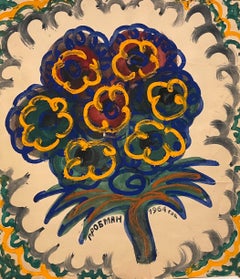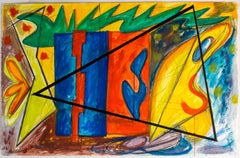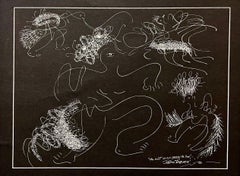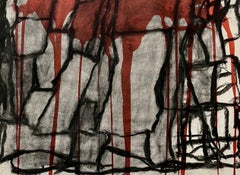Want more images or videos?
Request additional images or videos from the seller
1 of 9
Michail GrobmanPost Soviet Nonconformist Avant Garde Russian Israeli Gouache Painting Grobman1964
1964
$2,500List Price
About the Item
- Creator:Michail Grobman (1939, Russian)
- Creation Year:1964
- Dimensions:Height: 19.8 in (50.3 cm)Width: 25.5 in (64.77 cm)
- Medium:
- Movement & Style:
- Period:
- Condition:minor wear. small tears in margin. should mat out fine.
- Gallery Location:Surfside, FL
- Reference Number:1stDibs: LU3829401392
About the Seller
4.9
Platinum Seller
Premium sellers with a 4.7+ rating and 24-hour response times
Established in 1995
1stDibs seller since 2014
1,843 sales on 1stDibs
Typical response time: 1 hour
Authenticity Guarantee
In the unlikely event there’s an issue with an item’s authenticity, contact us within 1 year for a full refund. DetailsMoney-Back Guarantee
If your item is not as described, is damaged in transit, or does not arrive, contact us within 7 days for a full refund. Details24-Hour Cancellation
You have a 24-hour grace period in which to reconsider your purchase, with no questions asked.Vetted Professional Sellers
Our world-class sellers must adhere to strict standards for service and quality, maintaining the integrity of our listings.Price-Match Guarantee
If you find that a seller listed the same item for a lower price elsewhere, we’ll match it.Trusted Global Delivery
Our best-in-class carrier network provides specialized shipping options worldwide, including custom delivery.You May Also Like
1950s "Rectangle" Mid Century Abstract Gouache Painting
Located in Arp, TX
Opper Estate
Maroon Abstract
c. 1940-1950's
Gouache on Paper
15" x 18" Unframed
From the estate of Ruth Friedmann Opper & Jerry Opper. Ruth was the daughter of Bauhaus artist, Gustav Friedmann.
San Francisco Abstract Expression
A free-spirited wave of creative energy swept through the San Francisco art community after World War II. Challenging accepted modes of painting, Abstract Expressionists produced highly experimental works that jolted the public out of its postwar complacency.
Abstract Expressionism resulted from a broad collective impulse rather than the inspiration of a small band of New York artists. Documenting the interchanges between the East and West Coasts, she cites areas of mutual influence and shows the impact of San Francisco on the New York School, including artists such as Mark Rothko and Ad Reinhardt. San Francisco's Beat poets...
Category
Mid-20th Century American Modern Abstract Paintings
Materials
Paper, Gouache
'Fish, Dove and Musical Instrument', Italian School (circa 1940s)
Located in London, GB
'Fish, Dove and Musical Instrument', gouache on paper, from the Italian School of artists (circa 1940s). Surely this very attractive piece was inspired by Georges Braque (1882-1963) ...
Category
1940s Modern Abstract Paintings
Materials
Paper, Gouache
$1,147 Sale Price
30% Off
H 23.63 in W 17.33 in
Celestial Tondo Pointillist Composition
By Manfred Schwartz
Located in Astoria, NY
Manfred Schwartz (American, b. Poland, 1909-1970), Celestial Tondo, Pointillist Composition, Gouache on Paper, apparently unsigned, artist estate stamp to verso, with red dot sticker...
Category
1950s Modern Abstract Paintings
Materials
Paper, Gouache
Abstract Work on Paper Mid-Century Modernism Greek American Gouache Drawing
By Jean Xceron
Located in New York, NY
Abstract Work on Paper Mid-Century Modernism Greek American Gouache Drawing.
A modernist artist who emigrated to America from Greece in 1904, when he was fourteen years old, Jean Xceron is described as having a reputation as an artist that has mysteriously fallen into obscurity---especially since he was reportedly quite prominent during his lifetime. However, a partial explanation of that omission is the fact that many of his papers and early records have been lost. He was a painter of biomorphic abstractions and did collages, which were influenced by Dadaism.
Xceron was active in New York City when modernism was gaining influence. Of him during this period, it was written that his artistic role was "a vital link between what is commonly termed as the first-generation (the Stieglitz group, the Synchromists, etc.) and second-generation, the American Abstract Artists, the Transcendental Painting...
Category
1940s American Modern Abstract Drawings and Watercolors
Materials
Paper, Gouache
$4,800 Sale Price
20% Off
H 24 in W 20 in D 2 in
1950s "Sitting in Chair" Mid Century Figurative Pratt Graphic Arts Center
By Donald Stacy
Located in Arp, TX
Donald Stacy
"Sitting in Chair"
c.1950s
Gouache and oil pastel on paper
24" x 18" unframed
Came from artist's estate
*Custom framing available for additio...
Category
Mid-20th Century American Modern Abstract Drawings and Watercolors
Materials
Paper, Oil Pastel, Gouache
$570 Sale Price
40% Off
H 18 in W 24 in
1950s "Red Sun" Mid Century Abstract Art Students League NYC
By Donald Stacy
Located in Arp, TX
Donald Stacy
"Red Sun"
c.1950s
Gouache and oil pastel on paper
13.75" x 17" unframed
Unsigned
Came from artist's estate
*Custom framing available for additional charge. Please expect framing time between 3-5 weeks.
Donald Stacy (1925-2008) New Jersey
Studied: Newark School of Fine Art
The Art Students League...
Category
Mid-20th Century American Modern Abstract Drawings and Watercolors
Materials
Paper, Oil Pastel, Gouache
$430
H 17 in W 13.75 in
Modern Grey and Orange Geometric Abstract Leaf Pattern Painting
By John Little
Located in Houston, TX
Modern grey and white geometric abstract leaf pattern composition with orange accents by textile designer John Little. The work was created as a proposed design for a wallpaper and features the original color codes in the front lower left corner. Currently hung in a solid black frame with a large white margin.
Dimensions Without Frame: H 27.13 in. x W 31.5 in.
Artist Biography: A painter and textile designer, John Little is best known for gestural works filled with boldly explosive color that reflect the influences of his teacher Hans Hofmann and for his involvement in the Abstract Expressionist movement in East Hampton, where he moved in the late 1940s. In East Hampton Little congregated with Jackson Pollock, Lee Krasner, and the other artists who were the leading innovators in the New York School.
John Little was born in Sanford, Alabama. He left home at the age of fourteen to become an artist, and moved to Buffalo, New York, in 1923. After spending a year working as a stevedore on the docks to save money, he enrolled at the Buffalo Fine Arts Academy and developed an interest in singing. In 1927 he moved to New York City where he continued his vocal work and studied operatic literature. He also became involved in textile design, opening his own store in 1920, called John Little Studios: Fabric and Wallpaper Design. He ran the store until 1950.
In 1933 John Little resumed his painting studies at the Art Students League in New York under the guidance of George Grosz (1893-1959). The following year he made his first visit to East Hampton, Long Island, which he would eventually call home. Later in the decade, he traveled to Paris where he became familiar with European modernism. On his return to America, he taught textile design at the Pratt Institute in Brooklyn. He hired Josephine Watkins to work for him; she later became his wife. Little's textile store and teaching job gave him a financial security that was rare during the Depression, and he never found it necessary to find employment with the Works Progress Administration. At the end of the decade, John Little studied with Hans Hofmann (1880-1966) in New York and Provincetown. Little was greatly influenced by Hofmann, particularly by his views on color theory.
In 1942 John Little joined the Navy as an aerial photographer. In the late 1940s he purchased a rundown house on Three Mile Harbor...
Category
Early 20th Century Modern Abstract Drawings and Watercolors
Materials
Paper, Gouache
$1,200
H 28.63 in W 33.13 in D 1.13 in
Modern Orange, Brown, Yellow, and Black Geometric Abstract Pattern Painting
By John Little
Located in Houston, TX
Modern orange, brown, yellow, and black geometric abstract composition by textile designer John Little. The work was created as a proposed design for a wallpaper and features the original color codes in the front lower left corner. Currently hung in a solid black frame with a large white margin.
Dimensions Without Frame: H 35.5 in. x W 33.5 in.
Artist Biography: A painter and textile designer, John Little is best known for gestural works filled with boldly explosive color that reflect the influences of his teacher Hans Hofmann and for his involvement in the Abstract Expressionist movement in East Hampton, where he moved in the late 1940s. In East Hampton Little congregated with Jackson Pollock, Lee Krasner, and the other artists who were the leading innovators in the New York School.
John Little was born in Sanford, Alabama. He left home at the age of fourteen to become an artist, and moved to Buffalo, New York, in 1923. After spending a year working as a stevedore on the docks to save money, he enrolled at the Buffalo Fine Arts Academy and developed an interest in singing. In 1927 he moved to New York City where he continued his vocal work and studied operatic literature. He also became involved in textile design, opening his own store in 1920, called John Little Studios: Fabric and Wallpaper Design. He ran the store until 1950.
In 1933 John Little resumed his painting studies at the Art Students League in New York under the guidance of George Grosz (1893-1959). The following year he made his first visit to East Hampton, Long Island, which he would eventually call home. Later in the decade, he traveled to Paris where he became familiar with European modernism. On his return to America, he taught textile design at the Pratt Institute in Brooklyn. He hired Josephine Watkins to work for him; she later became his wife. Little's textile store and teaching job gave him a financial security that was rare during the Depression, and he never found it necessary to find employment with the Works Progress Administration. At the end of the decade, John Little studied with Hans Hofmann (1880-1966) in New York and Provincetown. Little was greatly influenced by Hofmann, particularly by his views on color theory.
In 1942 John Little joined the Navy as an aerial photographer. In the late 1940s he purchased a rundown house on Three Mile Harbor...
Category
Early 20th Century Modern Abstract Drawings and Watercolors
Materials
Paper, Gouache
$1,950
H 37 in W 35.13 in D 1.13 in
Modern Light Blue, Brown, and Black Geometric Abstract Circle Pattern Painting
By John Little
Located in Houston, TX
Modern light blue, brown, and black geometric abstract circle pattern painting by textile designer John Little. The work was created as a proposed design for a wallpaper and features the original color codes in the front lower left corner. Currently hung in a solid black frame with a large white margin.
Dimensions Without Frame: H 32.75 in. x W 35.63 in.
Artist Biography: A painter and textile designer, John Little is best known for gestural works filled with boldly explosive color that reflect the influences of his teacher Hans Hofmann and for his involvement in the Abstract Expressionist movement in East Hampton, where he moved in the late 1940s. In East Hampton Little congregated with Jackson Pollock, Lee Krasner, and the other artists who were the leading innovators in the New York School.
John Little was born in Sanford, Alabama. He left home at the age of fourteen to become an artist, and moved to Buffalo, New York, in 1923. After spending a year working as a stevedore on the docks to save money, he enrolled at the Buffalo Fine Arts Academy and developed an interest in singing. In 1927 he moved to New York City where he continued his vocal work and studied operatic literature. He also became involved in textile design, opening his own store in 1920, called John Little Studios: Fabric and Wallpaper Design. He ran the store until 1950.
In 1933 John Little resumed his painting studies at the Art Students League in New York under the guidance of George Grosz (1893-1959). The following year he made his first visit to East Hampton, Long Island, which he would eventually call home. Later in the decade, he traveled to Paris where he became familiar with European modernism. On his return to America, he taught textile design at the Pratt Institute in Brooklyn. He hired Josephine Watkins to work for him; she later became his wife. Little's textile store and teaching job gave him a financial security that was rare during the Depression, and he never found it necessary to find employment with the Works Progress Administration. At the end of the decade, John Little studied with Hans Hofmann (1880-1966) in New York and Provincetown. Little was greatly influenced by Hofmann, particularly by his views on color theory.
In 1942 John Little joined the Navy as an aerial photographer. In the late 1940s he purchased a rundown house on Three Mile Harbor...
Category
Early 20th Century Modern Abstract Drawings and Watercolors
Materials
Paper, Gouache
$1,500
H 34.38 in W 37.25 in D 1.13 in
Unique signed Mid Century Modern Abstract painting by renowned American painter
By Thomas Brownell Eldred
Located in New York, NY
THOMAS BROWNELL ELDRED
Untitled Mid Century Modern Abstraction, 1941
Gouache on paper
Hand signed and dated 1941 on the front
14 3/4 × 21 inches
Unique
Provenance: Acquired from the estate of Thomas Brownell Eldred
Accompanied by Certificate of Guarantee from Alpha 137 Gallery
Unframed
This gorgeously colored gouache painting on thick paper was created at a time when the Guggenheim Museum (Museum of Non-Objective Painting) was collecting Eldred's work, alongside works by Kandinsky and Bauer. Unique works like this by Eldred are very desirable in the marketplace. It typifies the artist's eclectic style, reflecting his involvement with Surrealism and the New York School. It also highlights Eldred’s excellent draftsmanship through the characteristic bright colors and patterns that he developed during his time as a naval wood pattern maker in the merchant marines...
Category
Mid-20th Century Modern Abstract Paintings
Materials
Watercolor, Gouache
More From This Seller
View AllPost Soviet Nonconformist Avant Garde Russian Israeli Gouache Painting Grobman
By Michail Grobman
Located in Surfside, FL
MIchail Grobman
Gouache and watercolor on paper
Hand signed Lower Left and Dated 1964.
Described inn Cyrillic Russian verso.
Dimensions: L:13.25" W: 11.75".
Michail Grobman (Russ...
Category
1960s Modern Abstract Paintings
Materials
Paper, Watercolor, Gouache
Large 80s Vibrant Dynamic Drawing/Painting Memphis Milano Era
By Peter Stevens
Located in Surfside, FL
it is currently unframed and will be sold thus. Similar in style to the 80s work of Elizabeth Murray. A bright, colorful expressive piece signed (labels are not included as it is un...
Category
1980s 85 New Wave Abstract Drawings and Watercolors
Materials
Conté, Charcoal, Gouache, Rag Paper, Graphite
Irene Rice Pereira Modernist Gouache Drawing Painting Abstract Expressionist Art
By Irene Rice Pereira
Located in Surfside, FL
Irene Rice Pereira,
Mixed Media on Paper (American, 1902-1971)
Titled "The East Wind Carries the Seed"
Hand signed l.r. "I. Rice Pereira".
Paper: 14.1/8"h x 18.25"w
Irene Rice Pe...
Category
Mid-20th Century Abstract Expressionist Abstract Paintings
Materials
Paper, Gouache
Bold Graphic Abstract Expressionist Mixed Media Painting Richard Snyder NYC Art
Located in Surfside, FL
Richard Snyder (American, born 1951)
Untitled
Mixed media painting including charcoal and watercolor
Hand signed to lower right
Dimensions: 30.0" W x 22.5" H x 0.1" D
Richard Snyder is particularly known for his large-scale abstract expressionist paintings exhibiting vibrant colors, often applied in an irregular manner with large gestural brushstrokes. He also was an accomplished sculptor and was amongst the downtown New York art-furniture scene spawned in the 1980s by the Soho gallery ‘Art et Industrie’ founded by Rick Kaufmann. Downtown New York, circa 1977-1980 was a hothouse of creative impulses that flew in the face of restrictions and ran headlong toward riotous expression. Punk, hip-hop, graffiti or neo-expressionism,
Kaufmann looked around for new talent that could create a new kind of art furniture. He felt the design of the day was so standardised, and he wanted to give voice to young artists and bring new ideas to market.
After receiving a BFA from the School of the Museum of Fine Arts in Boston, Snyder made his career in the fields of art and design, practicing sculpture, painting, furniture design and fabrication, interior design, cabinetmaking, construction and industrial design. Along with extensive experience in a wide variety of materials and processes, Snyder also possesses a wide range of visual and experiential vocabulary acquired in his many travels through the Americas, Africa, the Middle East and Central and Southeast Asia. Snyder considers his objects to be not just about form, function, color, material and process, but rather to be fantasies with spirit, magic and story. During his seventeen years with the Art et Industrie gallery, Snyder participated in five solo shows and more than twenty group shows, which established him as a major player in the American Art Furniture movement. His pieces have appeared in numerous publications and media around the world; and they are included in numerous private collections worldwide as well as in the permanent collection of The Art Institute of Chicago. Snyder guest-lectures at the Rhode Island School of Design in Providence, the New School in New York, and SUNY Purchase.
He was included in the seminal Magen H Gallery retrospective of Art et Industrie—a New York Movement. Art et Industrie was the first to exhibit Studio Alchemia, Shiro Takahama, and Ron Arad.
The retrospective included artists such as Forrest Myers, Terence Main...
Category
20th Century Abstract Expressionist Abstract Drawings and Watercolors
Materials
Paper, Charcoal, Watercolor, Gouache
Modernist Abstract Expressionist Watercolor Painting Bauhaus Weimar Artist
By Pawel Kontny
Located in Surfside, FL
Abstract watercolor composition bearing the influence of the earlier color-block compositions of Paul Klee.
Pawel August Kontny, (Polish-German-American artist) He was born in Laurahuette, Poland, in 1923, the son of a wealthy pastry shop owner. In 1939 he began studying architecture in Breslau where he was introduced to the European masters and to the work of some of the German Expressionists, soon afterward banned as "degenerate artists" and removed from museums throughout Germany by the Nazi regime. His studies were interrupted by World War II. Drafted into the German army, traveling in many countries as a soldier, he sketched various landscapes but in 1945, he was captured and held as a prisoner of war in Italy. After the war, he studied at the Union of Nuremberg Architects to help design buildings to replace ones destroyed in the war. He recorded his impressions of the local population and the landscapes through his watercolors and drawings. Pawel Kontny thereafter moved to Nuremberg, Germany, becoming a member of the Union of Nuremberg Architects and helping to rebuild the city's historic center. He soon decided to concentrate on his professional art career. He married Irmgard Laurer, a dancer with the Nuremberg Opera. Pavel Kontny 's career as an artist was launched with his participation in an all German exhibition, held at the Dusseldorf Museum in 1952. He held one-man shows in Germany, Switzerland and the United States. During his trip to the United States in 1960, Kontny became instantly enamored with Colorado, and decided to relocate to Cherry Hills with his wife and two children. He quickly established himself in the local art community, being affiliated for a time with Denver Art Galleries and Saks Galleries. His subject matter became the Southwest. During this time he received the Prestigious Gold Medal of the Art Academy of Rome. His extensive travel provided material for the paintings he did using his hallmark marble dust technique. he also worked equally in pastel, watercolor, charcoal and pencil-and-ink. in a style which merged abstraction and realist styles, influenced by Abstract Expressionist painting and South Western American landscapes. In the early 1960s he was one of only a few European-born professional artists in the state, a select group that included Herbert Bayer (1900-1985), a member of the prewar Bauhaus in Weimar and Dessau, Germany, and Roland Detre...
Category
Mid-20th Century American Modern Abstract Drawings and Watercolors
Materials
Watercolor, Archival Paper
Mod Abstract Expressionist Modernist Edward Avedisian Color Field Art Gouache
By Edward Avedisian
Located in Surfside, FL
Edward Avedisian Gouache Watercolor Abstract Painting on Arches paper. (notebook cover not included)
Unsigned, (bears name verso in pencil.)
Dimensions: 10" X 14"
Late 1970s, early ...
Category
1970s Abstract Expressionist Abstract Paintings
Materials
Watercolor, Gouache



